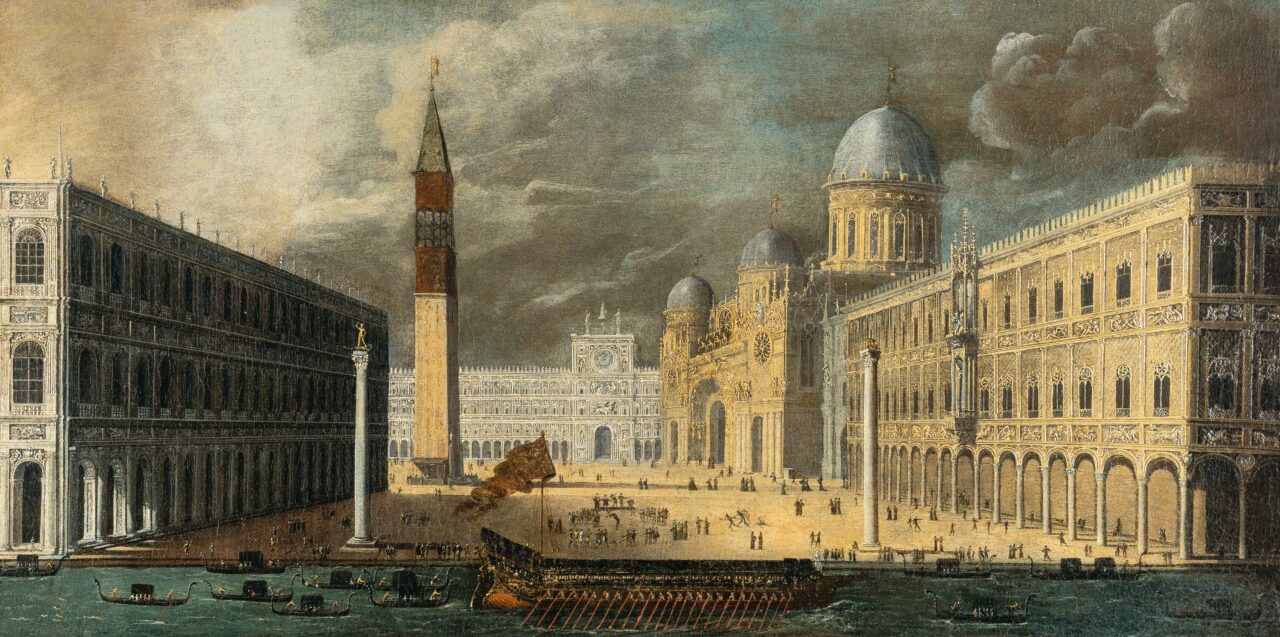Piazzetta San Marco,Venice
Details
Nappi A 31.
Literatur:
A.E. Austin, in: The fantastic visions of Monsù Desiderio, John and Mable Ringling Museum of Art, Ausstellungskatalog, Sarasota 1950, S. 22, Kat.-Nr. 34, Abb. 35;
Felix Sluys, Didier Barra et François de Nomé dits Monsù Desiderio, Paris 1961, S. 59, Kat.-Nr. 14 (ohne Abb.);
Maria Rosaria Nappi, François De Nomé e Didier Barra: l’enigma Monsù Desiderio, Mailand 1991, S. 84, Kat.-Nr. A 31, mit Abb. (mit abweichenden Maßangaben und als Verbleib unbekannt).
Provenienz:
J.H.C. Baring Esq., 9 March 1929, auf dem Keilrahmen mit Etikett;
Christie’s, London, Auktion, 24.7.1936, Los 57 (als “Italian School”);
Sotheby’s, London, Auktion, 8.12.2005, Los 345;
Gallery Pintelon Corinne, Aalst;
Privatbesitz, Süddeutschland.
Descrizione
François de Nomé is one of the most enigmatic artists to have worked in Italy in the first half of the 17th century. Until 1956, he and his compatriot Didier Barra were subsumed under the provisional name Monsù Desiderio. It was not until the research of Raffaello Causa that the artists’ separate identities were revealed. However, Maria Rosaria Nappi’s catalogue of works with separate attributions is the most well-founded discussion to date. It is known that De Nomé was born in Metz, but moved to Italy in 1602 and settled permanently in Naples following a stay in Rome. He painted fanciful architectural scenes in which he mixed existing buildings with imaginary architectural forms. However, he also depicted catastrophic incidents such as collapsing vaulted ceilings, which he staged like a “movie still”. It is not known whether De Nomé ever visited Venice. He probably drew inspiration for his detailed topographical views of the Piazzetta San Marco from contemporary engravings, for example by Joseph Heintz the Elder (1564-1609). He was certainly also familiar with the two depictions of the blazing Doge’s Palace by Joris Hoefnagel (1542-1601). The Bacino di San Marco, the heart of the Serenissima, opens up in a sharply drawn panorama. Gondolas float on the gently rippling water, somewhat schematically rendered, in a procession past St Mark’s Square. Clouds gather in the grey sky, while from the left, literally out of the blue, light falls upon the square and illuminates the marble-clad lower part of the Campanile. The Doge’s Palace, St Mark’s Basilica and the horizontal bar of the Torre dell’Orologio are also brightly illuminated, while the Biblioteca Marciana casts a large shadow over the scene. The square is bustling with activity. The citizens feel inclined to go outside again after having survived several plague epidemics. A multitude of elegantly dressed figures move across the square, exuberant music is playing from the pier. A circle of spectators has formed around a dancing acrobat. The Ascension Day festivities have begun, during which Venice renews the sposalizio del mare, its symbolic marriage vows to the sea. This is also indicated by the presence of the Bucintoro, the Doge’s magnificent gilded galleass, which rests on the water ready for departure. Every year, the Doge, accompanied by members of the clergy, foreign ambassadors and 168 oarsmen, sailed out onto the lagoon, where he threw a consecrated ring into the Adriatic as he passed the Lido. This rite dates back to 997, when Pietro II Orseolo set sail with a galley to put an end to the subjugation of the Dalmatian coastal towns by pirates. This act of liberation established the enduring rule of Venice over these coastal areas.
* Tutte le informazioni includono la commissione a carico dell'acquirente (27%) senza IVA e senza garanzia. Salvo errori.
** Tutte le informazioni più la commissione a carico dell'acquirente e l'IVA e senza garanzia. Salvo errori.
*** Con riserva: L'offerta è stata accettata al di sotto del limite. L'acquisizione dell'opera potrebbe essere ancora possibile nella nostra vendita post-asta.
R = Le opere d'arte regolarmente tassate
N = Opere d'arte soggette a tassazione differenziata e provenienti da un paese non UE
Non è consentita la riproduzione e la distribuzione privata o commerciale di tutte le illustrazioni delle opere esposte nell'archivio della mostra e dell'asta. Tutti i diritti riservati.


